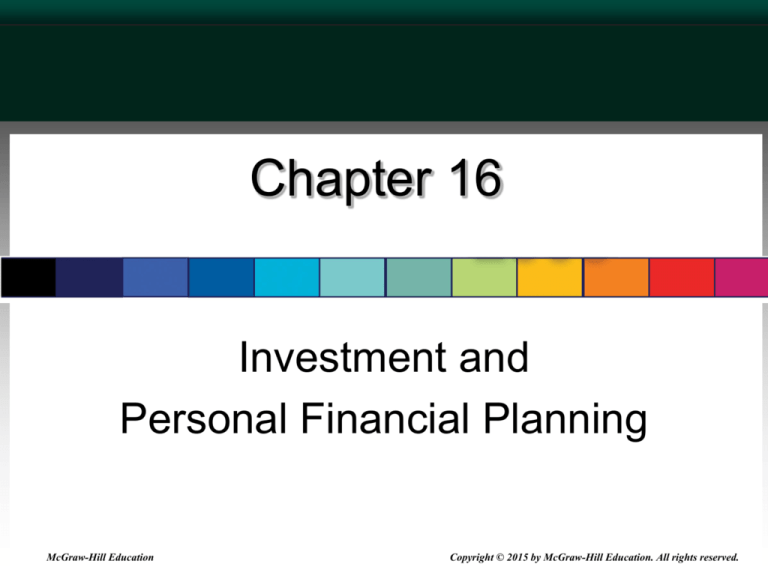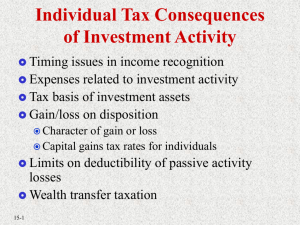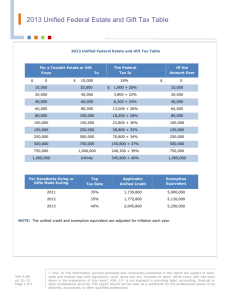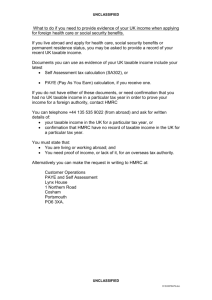
Chapter 16
Investment and
Personal Financial Planning
McGraw-Hill Education
Copyright © 2015 by McGraw-Hill Education. All rights reserved.
16-2
Objectives
• Determine the tax consequences of interest and
dividend income
• Explain how life insurance policies and annuity
contracts defer income
• Compute gain or loss recognized on security
transactions
• Compute the tax on short-term and long-term
capital gain
16-3
Objectives (continued)
• Determine the deduction for investment interest
expense
• Apply the passive activity loss limitation
• Compute a taxable gift by applying the annual and
lifetime exclusions
• Determine a decedent’s taxable estate
16-4
Business versus Investment
• Business activity
• Taxpayer commits time and talent on regular basis
• Profit is partially attributable to personal involvement
• Investment activity
• Taxpayer is owner of income-producing property
• Profit is primarily due to invested capital
• Taxpayer who devotes substantial
time to managing income-producing property
is still engaging in an investment activity
16-5
Investments in Financial Assets
• Securities include:
• Common and preferred stock
• Savings accounts, CDs, notes, and bonds
• Individuals can own financial assets directly or
indirectly through a mutual fund
• Mutual fund – diversified portfolio
of securities managed by regulated
investment company (RIC)
• Most popular investment vehicle on the market
16-6
Investments in Financial Assets
• Return on investment includes:
• Interest
• Dividends
• Qualified dividends taxed
at capital gain preferential rates
• 0%, 15%, or 20%
• Gain on sale of investment
16-7
Interest Income
• Interest on savings accounts, CDs,
and corporate bonds is ordinary
income
• Municipal bond interest income is
exempt from federal tax
• If bond is a private activity bond,
interest is an AMT preference
• Interest on U.S. debt (Treasury bills,
notes, bonds) is subject to federal tax
but exempt from state tax
16-8
Discounted Debt Obligations
• Cash basis investors who purchase bonds at a
market discount recognize the discount as ordinary
income when the bond is redeemed or sold
• Cash basis investors who purchase newly issued
corporate bonds with original issue discount (OID)
must amortize the discount over the life of the bond
• Amortized discount is recognized as ordinary income
16-9
Deferral with Life Insurance or Annuities
• Life insurance proceeds are excluded from
beneficiary’s gross income
• Certain life insurance policies build up cash
surrender value (CSV) over period that policy
is effect
• Annual increase in value (inside buildup)
is not recognized as income by owner
• If owner liquidates the policy, excess of
CSV over premiums paid is ordinary income
16-10
Deferral with Life Insurance or Annuities
• Owners of annuity contracts don’t
recognize annual increase in value
(inside buildup) as income
• Periodic annuity payment
• Portion representing return of owner’s investment is
excluded from gross income
• Excluded portion is based on exclusion ratio
• Exclusion ratio = owner’s investment/expected return
• Portion representing distribution of accumulated earnings
is taxed as ordinary income
16-11
Gains/Losses on Securities
• Gain or loss is realized on disposition of security
• Formula:
Amount realized
(Adjusted basis)
Gain (loss) realized
• Gains and losses on sale or
exchange of securities is
capital gain or loss
16-12
Gains/Losses on Securities
• Basis issues
• Reinvested dividends increase basis;
nontaxable distributions reduce basis
• Basis of shares sold determined under:
• specific identification method
• FIFO method
• average basis method
16-13
Worthless Securities and Bad Debts
• Worthless securities are treated
as sold on the last day of the
year for $0
• Loss is capital loss
• Nonbusiness bad debts (e.g.,
personal loans) are treated as
short-term capital loss
16-14
Exchanging Securities
• General rule: exchanges of securities
are taxable events (e.g. Intel for Nike)
• Nontaxable if:
• Exchange of stocks issued by the same corporation
• Exchange pursuant to corporate reorganization
• Basis of original stock becomes basis of new stock
16-15
Short-term and Long-term Gains and Losses
• Sale or exchange of capital asset held for one year
or less results in short-term gain or loss
• Short-term gains and losses are netted to one number
• Sale or exchange of capital asset held for more
than one year results in long-term gain or loss
• Separate 28% rate category for long-term gain or loss on
sale of collectibles and qualified small business stock
• Long-term gains and losses netted to one number
16-16
Netting of Capital Gains and Losses
• Capital losses are deductible to extent of capital
gains
• Net short-term loss is netted against net long-term gain
• $(15,000) net STCL + $22,000 net LTCG = $7,000 net LTCG
• $(15,000) net STCL + $11,000 net LTCG = $(4,000) net STCL
• Net long-term loss is netted against net short-term gain
• $(20,000) net LTCL + $29,000 net STCG = $9,000 net STCG
• $(20,000) net LTCL + $8,500 net STCG = $(11,500) net LTCL
16-17
Net Capital Gain
• Net capital gain may consist of short-term gain,
long-term gain, or both
• Short-term capital gain taxed at ordinary rate
• Long-term gain taxed at preferential rate
• 28% rate gain taxed at a
maximum 28% rate
• Other long-term gain taxed at:
• 0% if marginal rate on ordinary income is 10 or 15%
• 15% if marginal rate on ordinary income is 25, 28, 33, or
35%
• 20% if marginal rate on ordinary income is 39.6%
16-18
Unrecaptured Section 1250 Gain
• Gain on sale of business realty
(including rental property) is
taxed under a special rule
• Unrecaptured Section 1250 gain taxed at 25%
• Gain that would be recaptured as ordinary income under
full recapture rule (Section 1245 gain)
• Any remaining gain is treated as other capital gain
16-19
Net Capital Loss
• Limited deduction for net capital loss
• $3,000 deductible against ordinary income
• Nondeductible net capital loss carried forward
indefinitely
• Carryforward retains character as short-term or longterm loss
16-20
Investment Expenses
• Investment expenses are miscellaneous itemized
deductions (subject to 2% AGI floor)
• Investment fees, investment publications,
seminars
• Investment interest expense is itemized deduction
• Deduction limited to net investment income (investment
income less investment expenses)
16-21
Real Estate Investments
• Land is generally a capital asset – gain on sale is
taxed at preferential rates
• Real estate taxes paid are itemized deductions
• Mortgage interest payments are investment interest
expense
• Frequent sales of land may
cause land to be viewed as
inventory
16-22
Rental Real Estate
• Rental income and expenses reported on Part I,
Schedule E
• Rental property is depreciated using either a 27.5 or 39
year recovery period
• While rental real estate activities may have many
business characteristics, they are actually passive
activities
16-23
Passive Activities
• Passive activity is:
• Any rental activity
• An interest in a business in which
taxpayer doesn’t materially participate
• Material participation requires involvement in day-to-day
operations on a regular, continuous and substantial basis
• Classification of a rental or business activity as
passive doesn’t effect how income is taxed but
does effect the deductibility of losses
16-24
Passive Loss Limitation
• Loss on passive activity is only deductible to the
extent of other passive income
• No deduction against active income (wages, income from
material activities), and portfolio income (interest,
dividends)
• Nondeductible losses are carried
forward indefinitely
• Taxpayer can deduct unused losses
upon disposition of the business interest
16-25
Exception for Rental Real Estate
• Passive rental losses up to $25,000 can be
deducted without limit
• Taxpayer must actively manage the rent property
• $25,000 exception is reduced by 50% of AGI
in excess of $100,000
• Exception reduced to zero when AGI exceeds $150,000
16-26
Unearned Income Medicare Contribution Tax
• High-income individuals must pay
3.8% tax on unearned income
• Revenues are earmarked for
Medicare trust fund
• Tax imposed on lesser of:
• Net investment income
• Taxable interest, dividends, annuities, royalties, rents,
passive activity income, net capital gain
• Excess of AGI over threshold amount
• $200,000 for unmarried individuals (S and HH)
• $250,00 ($125,000) for MFJ (MFS)
16-27
Transfer Tax System
• Federal transfer tax system has three components
• Gift tax
• Estate tax
• Generation-skipping transfer taxes
• Unified gift and estate tax is based on cumulative
transfers during lifetime and at death
16-28
Gift Tax
• Gifts are excluded from donee’s gross income
• No income tax cost to donee
• Donor’s basis carries over to donee
• Donor may exclude $14,000 (2014) per year per
donee from taxable gifts
• Married couple can treat a gift made by one spouse
as made equally by each
• Gift-splitting doubles annual exclusion
• Gifts to spouse or charities are nontaxable
• Payment of tuition or medical costs of another individual is
not a taxable gift
16-29
Gift Tax Lifetime Exclusion
• If FMV of a gift exceeds the annual exclusion,
excess is a taxable gift
• Only the amount of a donor’s cumulative taxable gifts in
excess of a lifetime transfer tax exclusion
is taxed
• Exclusion is $5,340,000 in 2014
• Tax rate for taxable gifts in
excess of the exclusion is 40%
16-30
Taxable Estate
• Taxable estate includes the FMV of all assets:
• Owned by the decedent and transferred under a valid will
• Other property transferred because of death (e.g., life
insurance)
• Taxable estate is reduced by:
• Decedent’s debts
• Administrative and funeral expenses
• Unlimited marital deduction
• Bequests to charity
16-31
Estate Tax
• Taxable estate is reduced by decedent’s lifetime
transfer tax exclusion
• Exclusion is $5,340,000 in 2014
• Exclusion is reduced by any amount used during decedent’s
life to reduce taxable gifts for gift tax purposes
• Exclusion is increased by any amount of deceased spouse’s
exclusion not used at spouse’s death
• Tax rate for taxable estate in excess of exclusion is 40%
16-32
Income Tax Consequences
• Bequests and inheritances are excluded from the
beneficiary’s gross income
• Beneficiary’s basis in inherited property equals
property’s FMV
• Appreciation in property escapes income taxation
16-33







